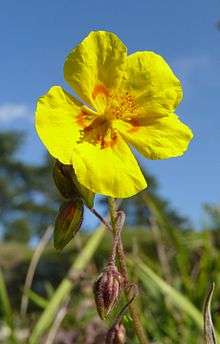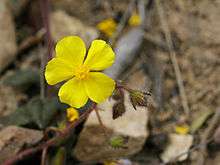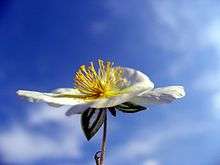Helianthemum
Helianthemum /ˌhiːliˈænθɪməm/,[1] known as rock rose, sunrose, rushrose, or frostweed,[2] is a genus of about 110[3] species of flowering plants in the family Cistaceae. They are widely distributed throughout the Northern Hemisphere, especially in the Mediterranean.[3]
| Helianthemum | |
|---|---|
 | |
| Helianthemum nummularium | |
| Scientific classification | |
| Kingdom: | Plantae |
| Clade: | Tracheophytes |
| Clade: | Angiosperms |
| Clade: | Eudicots |
| Clade: | Rosids |
| Order: | Malvales |
| Family: | Cistaceae |
| Genus: | Helianthemum Mill. |
| Species | |
|
See text | |
New World species formerly classified as Helianthemum have been transferred to genus Crocanthemum.[4][5]
Description
These are usually shrubs or subshrubs, and some are herbaceous annuals or perennials. The leaves are oppositely arranged, but some plants may have alternately arranged leaves along the upper stems. The flowers are solitary or borne in an array of inflorescence types, such as panicles, racemes, or headlike clusters. The flower has three inner sepals and two smaller outer sepals. It has five petals usually in shades of yellow, orange, or pink. The style at the center is tipped with a large stigma. The fruit is a capsule containing many seeds.[3]
Ecology
Helianthemum are known to form symbioses with mycorrhizal fungi. In the Mediterranean they are associated with Terfeziaceae, the desert truffles. Together, plant and fungus may have a beneficial effect on the arid local landscapes, preventing soil erosion and desertification. Some symbiotic pairs include Helianthemum salicifolium and the truffle Tirmania nivea, and H. guttatum and T. pinoyi.[6]
One of the most commonly observed mycorrhizae on Helianthemum is a member of a different family, Cenococcum geophilum. This fungus is not host-specific, and it often associates with oaks, as well. Some studies suggest that Helianthemum and oaks growing together in a habitat may "share" their mycorrhizae.[7]
Helianthemum are food plants for the larvae of some Lepidoptera species, such as the large grizzled skipper and the silver-studded blue.[8] The leaf miners Bucculatrix helianthemi and B. regaella both feed exclusively on Helianthemum sessiliflorum, as does Coleophora eupreta. C. ochrea is limited to Helianthemum, and C. bilineella and C. potentillae have been observed on the genus.
Cultivation
Several Helianthemum species, and the numerous hybrids and cultivars derived from them, are widely grown as ornamental plants, popular in rockeries. A broader range of colours is available among the cultivars, including bright salmon-pink to dark red. They are best grown in well-drained soil in full sun, and have a long flowering period from spring to summer.[9] Numerous cultivars have gained the Royal Horticultural Society's Award of Garden Merit:[10]
Selected species

.jpg)

- Helianthemum aegyptiacum
- Helianthemum almeriense
- Helianthemum apenninum – white rockrose
- Helianthemum asperum
- Helianthemum canariense
- Helianthemum canum – hoary rockrose
- Helianthemum caput-felis
- Helianthemum cinereum
- Helianthemum coulteri
- Helianthemum croceum
- Helianthemum guerrae
- Helianthemum hirtum
- Helianthemum hymettium
- Helianthemum jonium
- Helianthemum kahiricum
- Helianthemum lavandulifolium
- Helianthemum ledifolium
- Helianthemum leptophyllum
- Helianthemum lipii
- Helianthemum lunulatum
- Helianthemum marifolium
- Helianthemum morisianum
- Helianthemum nummularium – common rockrose
- Helianthemum oelandicum – alpine rockrose (syn. Helianthemum montanum)
- Helianthemum oelandicum subsp. alpestre (syn. H. alpestre)
- Helianthemum oelandicum subsp. italicum (syn. H. italicum)
- Helianthemum oelandicum subsp. oelandicum
- Helianthemum oelandicum subsp. orientale (syn. H. orientale)
- Helianthemum oelandicum subsp. rupifragum (syn. H. rupifragum)
- Helianthemum origanifolium
- Helianthemum pannosum
- Helianthemum papillare
- Helianthemum piliferum
- Helianthemum pilosum
- Helianthemum propinquum[21]
- Helianthemum rossmaessler
- Helianthemum salicifolium
- Helianthemum sanguineum
- Helianthemum sessiliflorum
- Helianthemum songaricum
- Helianthemum squamatum
- Helianthemum stipulatum
- Helianthemum villosum
- Helianthemum virgatum
- Helianthemum viscarium
- Helianthemum viscidulum
References
- Sunset Western Garden Book. 1995. 606–07.
- Helianthemum. Integrated Taxonomic Information System (ITIS).
- Helianthemum. Flora of China.
- "Crocanthemum". Royal Botanical Gardens, Kew. Retrieved 2019-12-08.
- Sorrie, B. A. (2011). Transfer of North American Helianthemum to Crocanthemum (Cistaceae): New combinations. Phytologia 93(2), 270-71.
- Díez, J., et al. (2002). Molecular phylogeny of the mycorrhizal desert truffles (Terfezia and Tirmania), host specificity and edaphic tolerance. Mycologia 94(2), 247-59.
- Dickie, Ian A.; Guza, Rebecca C.; Krazewski, Sarah E.; Reich, Peter B. (2004). "Shared ectomycorrhizal fungi between a herbaceous perennial (Helianthemum bicknellii) and oak (Quercus) seedlings". New Phytologist. 164 (2): 375–382. doi:10.1111/j.1469-8137.2004.01177.x.
- Thomas, C. D.; Glen, S. W. T.; Lewis, O. T.; Hill, J. K.; Blakeley, D. S. (1999-02-01). "Population differentiation and conservation of endemic races: the butterfly, Plebejus argus". Animal Conservation. 2 (1): 15–21. doi:10.1111/j.1469-1795.1999.tb00044.x. ISSN 1469-1795.
- RHS A-Z Encyclopedia of Garden Plants. United Kingdom: Dorling Kindersley. 2008. p. 1136. ISBN 978-1405332965.
- "AGM Plants - Ornamental" (PDF). Royal Horticultural Society. July 2017. p. 46. Retrieved 3 March 2018.
- "RHS Plant Selector - Helianthemum 'Amy Baring'". Retrieved 30 July 2020.
- "Helianthemum 'Fire Dragon'". RHS. Retrieved 31 July 2020.
- "RHS Plant Selector - Helianthemum 'Henfield Brilliant'". Retrieved 30 July 2020.
- "RHS Plant Selector - Helianthemum 'Jubilee'". Retrieved 30 July 2020.
- "RHS Plant Selector - Helianthemum 'Mrs C.W. Earle'". Retrieved 30 July 2020.
- "RHS Plant Selector - Helianthemum 'Rhodanthe Carneum'". Retrieved 30 July 2020.
- "RHS Plant Selector - Helianthemum 'The Bride'". Retrieved 30 July 2020.
- "RHS Plant Selector - Helianthemum 'Wisley Primrose'". Retrieved 30 July 2020.
- GRIN Species Records of Helianthemum. Germplasm Resources Information Network (GRIN).
- "Helianthemum". Royal Botanical Gardens, Kew. Retrieved 2019-12-08.
- "Helianthemum propinquum". Natural Resources Conservation Service PLANTS Database. USDA. Retrieved 14 December 2017.
External links
| Wikimedia Commons has media related to Helianthemum. |
